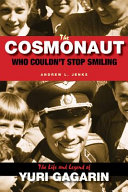
The Cosmonaut who Couldn't Stop Smiling: the life and legend of Yuri Gagarin
By - Jenks, Andrew L.
Floor
-
Floor 2
ISBN 10 - 0875804470
ISBN 13 - 9780875804477
Book Status
-
1 Qnty Available with us.
Subject
-
Soviet Union--Astronauts
Shelf No
-
13
Call Number
-
629.4500 JEN
Physical Description
-
323 pages) : illustrations, portraits.
Notes
-
Includes Bibliographical References and Index.